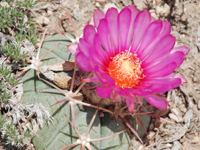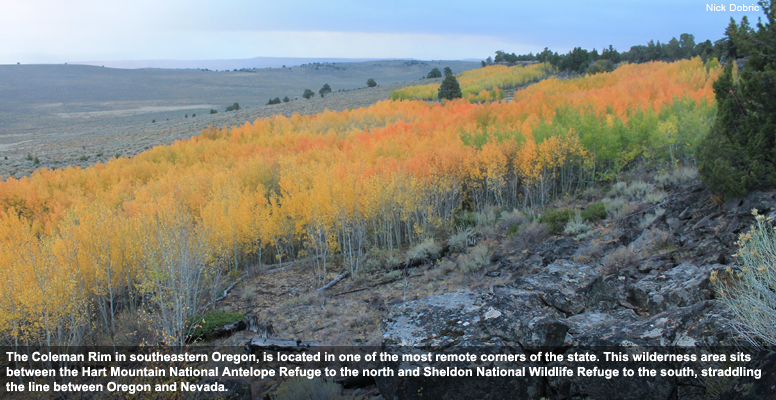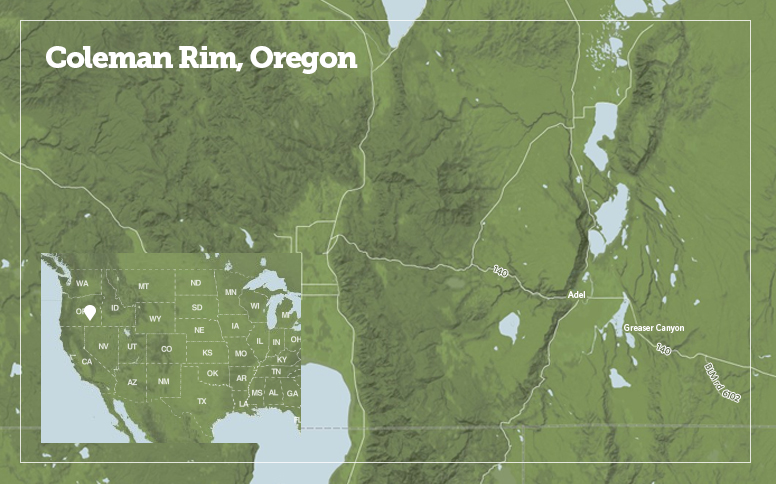Explore the Natural Link Between Oregon and Nevada at Coleman Rim
The Pew Charitable Trusts is working with local organizations throughout the West and in Washington to ensure that planners at the Bureau of Land Management, or BLM, recognize the scientific, economic, and cultural imperatives to keep our West wild.
Profile
 Hikers, horseback riders, and hunters who make their way up Coleman Rim, in one of the most remote corners of southeastern Oregon, earn a rare experience in an increasingly urban country. From the higher elevations, visitors can take in the vast sky overhead while gazing out at a mosaic of sagebrush, old-growth juniper, and scattered stands of aspen.
Hikers, horseback riders, and hunters who make their way up Coleman Rim, in one of the most remote corners of southeastern Oregon, earn a rare experience in an increasingly urban country. From the higher elevations, visitors can take in the vast sky overhead while gazing out at a mosaic of sagebrush, old-growth juniper, and scattered stands of aspen.
Most of this remote country is public land managed by the U.S. Bureau of Land Management (BLM). It sits between the Hart Mountain National Antelope Refuge to the north and Sheldon National Wildlife Refuge to the south, straddling the line between Oregon and Nevada. Coleman Rim provides an important migratory pathway for pronghorn and key habitat for species such as the greater sage-grouse, mule deer, California bighorn sheep, and songbirds. Abundant natural springs support the flora and fauna endemic to this ecological hot spot.

This backcountry offers opportunities for solitude as well as primitive and unconfined recreational opportunities. The bureau is drafting an amended Resource Management Plan for the 3.2-million-acre Lakeview District in Oregon, which includes Coleman Rim.
The agency protects only 15 percent of the district as wilderness study areas and has no designated wilderness. That leaves the rest of the landscape susceptible to degradation by off-road vehicles and energy infrastructure such as pipelines and power lines. The Pew Charitable Trusts is working with the Oregon Natural Desert Association to conserve ecologically important places such as Coleman Rim throughout the Lakeview District.
Learn more about the BLM's Lakeview District planning process.
Notable plants and animals
The area around Coleman Rim includes scattered stands of aspen, a unique characteristic of BLM-managed lands in the region. Sensitive plants, such as the Soldier Meadows cinquefoil, also are found in the broader area. Greater sage-grouse are present, and the varied topography and vegetation afford extensive habitat and cover for mule deer.
Visit Coleman Rim

Travel tips
Be sure to bring all the supplies you need because there are no services once you leave Adel. This includes drinking water, food, and a spare tire for your vehicle. Temperatures fluctuate greatly in the high desert so be prepared for all types of weather.
Driving directions
From Adel, OR, (gas is available), continue east on State Route 140 up the Greaser Canyon.
After 15.5 miles, turn right (south) on BLM Road 6102 (graded road but use caution if wet).
Within a half mile, turn right again.
BLM Road 6102 borders the unit on the east, becoming progressively worse for vehicle travel. There are some primitive campsites and other pull-offs where it is possible to park and hike.






